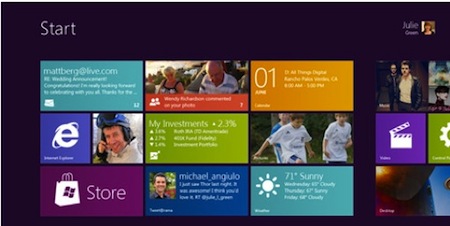
Microsoft’s Steven Sinofsky and Julie Larson-Green both described the new system, which is code-named Windows 8, as a real attempt to modernize Windows. They said it’s the first attempt to rethink the basic operating system’s layout since Windows 95.
[aditude-amp id="flyingcarpet" targeting='{"env":"staging","page_type":"article","post_id":297212,"post_type":"story","post_chan":"none","tags":null,"ai":false,"category":"none","all_categories":"business,dev,mobile,","session":"B"}']“I would say this is even bigger,” Mossberg said. He later described it as “pretty radical” and speculated that some longtime Windows customers might be “shocked” by the changes.
So what prompted that kind of response? You can read more about the demo in this blog post from Microsoft, but the most noticeable difference is a new layout that was clearly inspired by Windows Phone 7. Applications and other elements are laid out as tiles, and users swipe between different screens or programs with their fingers.
AI Weekly
The must-read newsletter for AI and Big Data industry written by Khari Johnson, Kyle Wiggers, and Seth Colaner.
Included with VentureBeat Insider and VentureBeat VIP memberships.
Beyond taking inspiration from Windows Phone 7, the operating system is clearly designed for a tablet computer — in fact, most of the demo ran on a tablet. Sinofsky and Larson-Green said it’s all one operating system, which will customize certain elements depending on whether it’s running on a touch interface (a tablet) or a keyboard and mouse (a desk top or laptop). The goal, Sinofsky said, is to create a touch-centric, responsive experience similar to what we’ve seen on the iPad, but with all the benefits of running the full version of Windows.
Sinofsky declined to offer a release date, but he noted that Windows is normally released every two to three years. So with Windows 7 coming out in fall 2009, that means the next version could come out as soon as this fall — except that Sinofsky also said, “It won’t be this fall.” So sometime in 2012 seems like a safe bet.
VentureBeat's mission is to be a digital town square for technical decision-makers to gain knowledge about transformative enterprise technology and transact. Learn More
